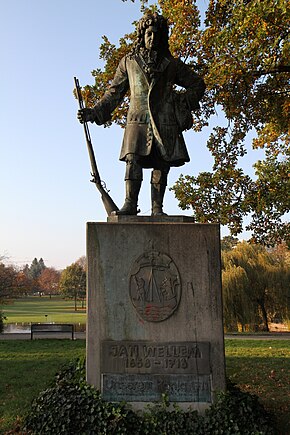Jan Wellem memorial
The Jan Wellem memorial in Cologne-Mülheim depicts Johann Wilhelm von der Pfalz and goes back to the foundation of the Andreae family of textile manufacturers.
In the course of industrialization and growth, the Cologne city area was expanded, and finally the question of incorporating Mülheim into Cologne came up. The struggle for independence was given up in 1913. Mülheim saw no way out and the city council decided to join Cologne. The alternative would have been Mülheim as an exclave in the Cologne city area. Above all, the good financial situation of the city of Mülheim, where numerous prosperous industrial companies were based, spoke against the incorporation. After the city council, the provincial government decided to include Mülheim in Cologne on April 1, 1914. The citizens' initiative even collected around 4,000 signatures against this decision and submitted the petition to the Reichstag in vain. The Reich government officially confirmed the incorporation on June 10, 1914.
In the final phase of this dispute, the Mülheim manufacturer Christoph Andreae donated the Jan Wellem monument. Numerous Mülheim handicrafts and industrial companies belonged to the Lutheran or Reformed owners, whose settlement went back to the elector's tolerant denominational policy. Like all Protestants, the Andreae family had to leave Cologne in 1714. Their cloth manufacture, founded in Cologne in 1687, was also relocated to Mülheim.
On June 18, 1714, the Andreae family received the right to live in Mülheim. On the occasion of the company's 200th anniversary in Mülheim (1714–1914), but not when the company was founded, Christoph Andreae donated the memorial. The inauguration took place in Cologne-Mülheim on April 28, 1914, around 28 days after the incorporation, but almost two months before the correct anniversary date. Johann Wilhelm visited Mülheim several times, because this was on the way to Bensberg. The neighboring species Königsforst and Buchforst were among the elector's hunting grounds. During a visit to Mülheim in 1711, Johann Wilhelm became the rifle king of the St. Sebastianus rifle club and was given a chain with a bird and a shield.
The 3.15 meter high bronze figure created by Eduard Schmitz shows Jan Wellem in hunting clothes with boots, rifle and three-master. The statue stands on a Baroque pedestal with the Mülheim city coat of arms. Under the city coat of arms there are two panels with inscriptions: "Jan Wellem (1658–1716)" and "Our King 1711".
The original location of the monument was on the south side of Wiener Platz . After the Second World War , the monument was moved to the Stadtgarten at the junction of Jan-Wellem-Strasse and Fürstenberger Strasse. In Iris Benner's publication, the photo of the monument is shown before the official inauguration.
The foundation of the monument was at least partially politically motivated. The company anniversary is clearly to be put in the background, because the same Andreae family also donated the Bismarck monument in Cologne in the course of the Kulturkampf . In this context, the foundation's political motives are to be seen as dominant.
literature
- Robert Friedl: Jan Wellem in Cologne . In: The gate. Journal of the Düsseldorfer Jonges , Volume 7, 2008, pp. 16-17.
- Iris Benner: Cologne Monuments 1871–1918. Aspects of bourgeois culture between art and politics . Stadtmuseum, Cologne 2003, ISBN 3-927396-92-3 , p. 233 (also dissertation, University of Cologne 2002).
- Joseph Theele : Jan Wellem Monument. In: Hermann Wieger (Ed.): Handbook of Cologne . Weidlich reprints, Frankfurt / M. 1979, ISBN 3-8035-1036-8 , p. 228 (unchanged reprint of the Cologne 1925 edition).
Web links
- Our elector is a king in Cologne . In: Express , May 5, 2008; accessed on May 24, 2017
- Photos of the monument on koeln-muelheim.net; Retrieved June 18, 2008
- Photos of the monument on wildlife-web.de; Retrieved June 18, 2008
Individual evidence
- ^ Yearbook for History and Regional Studies . Volume 8. History and Local History Association, Rechtsrheinisches Köln, Cologne 1982, p. 49
Coordinates: 50 ° 57 ′ 30.1 ″ N , 7 ° 0 ′ 23.4 ″ E
